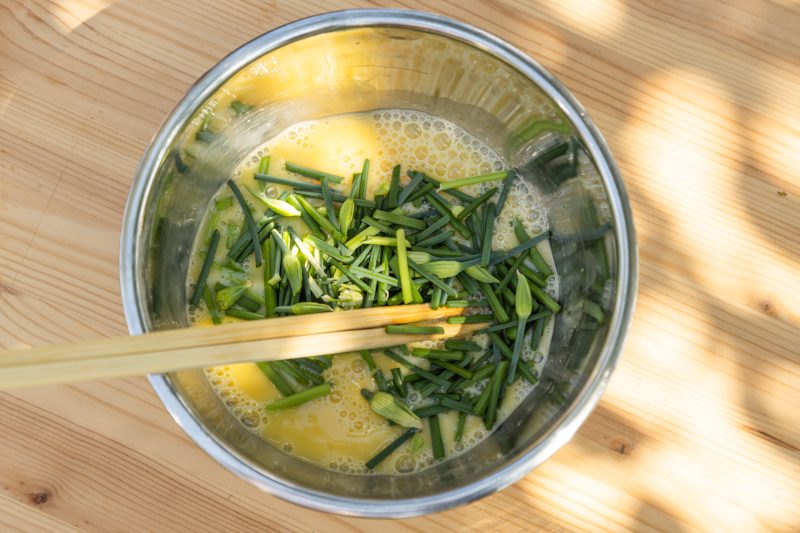Chive Flowers Scrambled Eggs & Stir-Fried Beancurd with Celery
芹菜炒豆腐乾

Dried tofu, also known as dried bean curd or tofu skin, is a popular ingredient in various Asian cuisines, particularly in China, Japan, Korea, and Southeast Asian countries. It is made from soybeans, just like regular tofu, but undergoes a different process to achieve a unique texture and flavor.
Chive Flowers Scrambled Eggs
Ingredients
Leek Pavilion 1 small handful 50-80 grams
3 eggs 🥚
oil 2-3 tbsp
Salt 🧂 pinch
Production time: within 10 minutes
Number of diners: 1-2
Production steps:
1. Wash the leek pavilion, cut into sections and set aside
2. Beat eggs with salt
3. Stir-fry the eggs in the oil pan and set aside
4. Add the scrambled eggs and stir well, add salt to taste and to serve.
韭菜花 炒雞蛋
食材
韭菜亭1小把50-80克
雞蛋🥚3个
油 2-3 tbsp
盐🧂少許
制作时间:10分钟内
用餐人数:1-2
制作步骤:
1,韭菜亭洗净,切段备用
2,雞蛋加盐打散
3,雞蛋下油锅炒散备用
4,加入炒好的雞蛋炒匀,加盐入味,装盘
Stir-Fried Dried Tofu with Celery
Ingredients:
200g dried tofu
Celery 100g
30 grams shallot
Accessories:
cooking oil 1, 1/2 tbsp
pinch of salt
(Ginger, Garlic, Soy Sauce)
Production steps:
Dried tofu can be cultured in strips for later use.
Cut the celery into small pieces, cut the shallots into small pieces, (you can add sliced ginger and garlic) for later use.
Heat the frying pan, introduce oil to heat up, add shallots (sliced ginger and garlic) and stir until fragrant.
Add dried tofu and stir fry for a while.
Add celery and stir-fry.
Add salt (or a little soy sauce) and stir fry evenly to serve.
芹菜炒豆腐乾
食材:
豆腐乾 200克
芹菜 100克
小蔥30克
辅料:
食用油1,1/2tbsp
盐少許
(姜,蒜,酱油)
制做步驟:
豆腐乾培養條狀備用。
芹菜切成小段,小香蔥切小段,(可以加入姜、蒜片)備用。
炒鍋上火,引入油燒熱,下小蔥(薑蒜片)煸香。
放入豆腐乾翻炒一會。
放入芹菜炒斷生。
調入鹽(或少許醬油)翻炒均勻即可裝盤。
Here’s an overview of how dried tofu is made:
- Soybean preparation: The process begins with soybeans, which are soaked in water to rehydrate them and remove impurities. After soaking, the soybeans are ground into a fine paste.
- Coagulation: The soybean paste is then heated, and a coagulant (usually calcium sulfate or magnesium chloride) is added to curdle the mixture. This results in the formation of solid curds.
- Pressing: The curds are then pressed to remove excess moisture, leaving behind a more solid mass.
- Shaping and drying: The pressed tofu is shaped into flat, thin sheets or sticks, which are then dried through various methods. Traditionally, they were sun-dried, but nowadays, commercial production uses ovens or dehydrators for more consistent results.
The dried tofu has a pale yellow or beige color, and its texture is rather firm and chewy. The drying process concentrates the soybean flavors and results in a slightly nutty and savory taste, making it a popular ingredient in a wide range of dishes.
Uses of dried tofu:
- Rehydration and cooking: Before using dried tofu, it needs to be rehydrated in water. Once softened, it can be sliced, diced, or cut into strips, and then added to various stir-fries, soups, stews, and hotpots. It absorbs the flavors of the surrounding ingredients and adds its unique taste and texture to the dish.
- Vegan and vegetarian dishes: Dried tofu is an excellent source of plant-based protein and is often used in vegetarian and vegan recipes as a meat substitute.
- Dim sum: In Chinese cuisine, dried tofu is commonly used as a filling for dim sum dishes like stuffed rolls or dumplings.
- Snacks: In some Asian cultures, dried tofu can be enjoyed as a snack. It may be seasoned with spices or served with dipping sauces.
- Braised dishes: Dried tofu is also used in braised dishes, where it soaks up the flavorful sauce, becoming tender and delicious.
Dried tofu is a versatile and nutritious ingredient that has been a staple in Asian cooking for centuries. Its popularity continues to grow as more people discover its unique taste and texture, and as plant-based diets gain traction worldwide.





